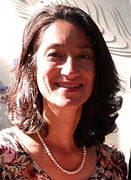Diana Asks the Big Questions
October 2011
For this month’s spotlight, we’re introducing a community member that we admire for their innovations in science education: Diana Vélez. Searching for rare plants and animals with her family is one of Diana Vélez’s favorite activities. In between tidepooling, bird watching, and exploring new outdoor locations, Diana is working to enhance and improve science teaching in classrooms throughout the Bay Area.
 Diana started her career as a teacher, but soon decided that to teach science, she should be more involved in her own knowledge and discovery of the natural world and scientific wonders. As Diana studied science, she transitioned from teaching to coaching other teachers in their science lessons. She directed and developed the Ocean Club, which teaches K-5 students about the ocean and gives them hands-on experience with water through restoration projects in their local water sheds. Diana was also a member of the team that designed the science-intensive Korematsu Discovery Academy at Stonehurst Elementary in Oakland.
Diana started her career as a teacher, but soon decided that to teach science, she should be more involved in her own knowledge and discovery of the natural world and scientific wonders. As Diana studied science, she transitioned from teaching to coaching other teachers in their science lessons. She directed and developed the Ocean Club, which teaches K-5 students about the ocean and gives them hands-on experience with water through restoration projects in their local water sheds. Diana was also a member of the team that designed the science-intensive Korematsu Discovery Academy at Stonehurst Elementary in Oakland.
Although these programs have touched the lives of thousands of students and gotten them excited about and involved with science, Diana’s own path of scientific questioning is not over. While these programs answered the question: “how do we teach more science in schools,” Diana had another question: how to we improve science teaching and make it more accessible to all students?
Diana currently works as a Full Option Science System (FOSS) Program Specialist and a Bay Area Science Project (BASP) Professional Developer. Through both of these positions, she is able to reach even more students and introduce them to exciting science lessons and great science instruction.
Through both the FOSS and the BASP, Diana works to train teachers on how to bring exciting science lessons into their classrooms, develop elementary school science lessons so teachers are more confident in their instruction, and develop new learning tools such as science notebooks and discussions that make science education more accessible to students who are studying English or who come from different cultural and educational backgrounds .
Science is a life-long pursuit that requires continual development by both teachers and students. Like any good scientist, Diana did not stop at the question of how to increase science in classrooms, but instead pushed forward and asked the bigger question: how do we make science learning better.
Diana fondly remembers her childhood nights spent in the desert, examining the stars, and summers exploring the different ecosystems of the coast, mountains, and forest. Diana now uses her career to explore the different methods of teaching, learning, and science education in the classrooms of the Bay Area and aims to provides kids with the opportunities that she had at their age.
When Diana goes into classrooms to aid teachers in their science development, one of her favorite activities is to listen to the students freely discuss and hypothesize about the natural world. Although this activity teaches the students about science, as with everything else Diana does, this activity also pushes learning one step further. In discussion groups, in addition to learning about facts, kids gain confidence in their ability to hypothesize, reason, and ‘do’ science. It can’t get any better than that!